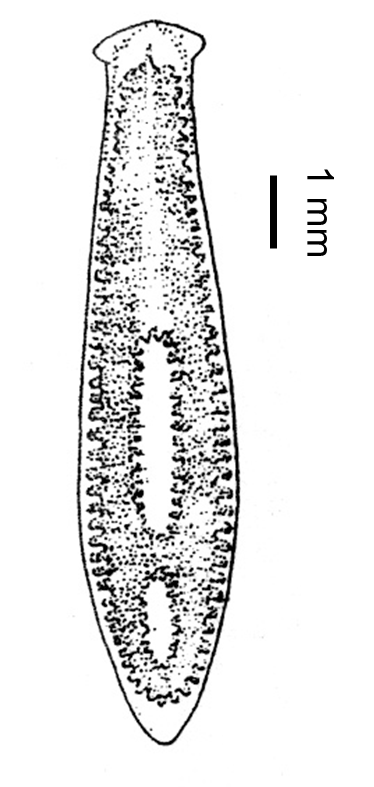- Scientific name: Seidlia remota
- Species of Greatest Conservation Need (MA State Wildlife Action Plan)
- Special Concern (MA Endangered Species Act)
Description

A drawing of a Sunderland planarian.
The Sunderland spring planarian is a free-living, freshwater flatworm (Smith 2001). Like other freshwater flatworms, it is long and flat, but the Sunderland spring planarian can be distinguished by its several small eyes tightly arranged in an arc along the front end of its body. This species is uniformly pigmented on its back, ranging in color from light olive in smaller specimens to reddish brown in larger specimens. The underside is grayish-white in color. Mature specimens range from 10-17 mm (0.4 to 0.67 in) in length (Smith 1988). Identification of flatworms is difficult because it requires knowledge of specific anatomical features of planaria.
The Sunderland spring planarian is similar to many other flatworms. It can be distinguished from other Massachusetts flatworms by the several small eyes tightly arranged in an arc along the anterior region of the body. It occurs together with another flatworm, Phagocata morgani morgani that is whiter in color. Identification keys sufficiently illustrate the differences among the flatworms that are found in southern New England (Smith 2000).
Life cycle and behavior
The life history and behavior are poorly known for this species. Like other free-living flatworms, the Sunderland spring planarian easily glides over the bottom substrate under water. Those specimens found downstream of the spring coexist with another flatworm Phagocata morgani morgan (D.G. Smith, personal communication, 2003). Captive live specimens of the Sunderland spring planarian deposited cocoon-like structures, although copulation has not been studied for this species.
Distribution and abundance
The Sunderland spring planarian is only known from Massachusetts and is the only member of its genus in North America. The Sunderland spring planarian is known from only one location in western Massachusetts. There are other possible localities in the area that have not yet been explored (D.G. Smith, personal communication 2003).
Little is known regarding the status of the Sunderland Spring Planarian. The population is known from only one site. It is listed under the Massachusetts Endangered Species Act as a species of Special Concern. All listed species are protected from killing, collecting, possessing, or sale and from activities that would destroy habitat and thus directly or indirectly cause mortality or disrupt critical behaviors. In addition, listed animals are specifically protected from activities that disrupt nesting, breeding, feeding, or migration.
Habitat
The Sunderland spring planarian is restricted to a cold spring in Sunderland, Massachusetts. This spring has water temperatures of 8.5-9.0 °C (47.3-48.2 °F) throughout the year. The greatest concentration of this planarian can be found living in the spring, but some animals are found just downstream of the spring on the undersides of stones and cobbles.
Healthy habitats are vital for supporting native wildlife and plants. Explore habitats and learn about conservation and restoration in Massachusetts.
Threats
Pollution from development and gravel excavation operations near the spring site is a possible threat to this species. Any changes in water quality within the narrow habitat of this species could also pose a threat.
Conservation
Survey and monitoring
The Sunderland spring planarian has not been positively identified since the late 1980s. The limited survey effort have contributed to the lack of knowledge to its distribution and status in Massachusetts. Surveys are needed to redocument this species at its historical sites and in new waterbodies that may support the species. Monitoring is recommended every five years or to the extent practical at its historical site.
Management
Pollution of the spring, where the species is found should be avoided, mitigated, or eliminated. Other human disturbance of this and surrounding habitat should be avoided.
Research needs
More information on the life history, distribution, and habitat requirements of this species would help in its preservation in Massachusetts. Surveys should target it historical site and new potentially suitable sites. Species differentiation using genetic analyses within the Seidlia genus is warranted to confirm its species or subspecies status including from S. schmidti (Sluys et al. 2009).
References
Kawakatsu, M., and Mitchell. R.W. 1998. Redescription of a North American freshwater planarian, Seidlia remota (Smith 1988) with taxonomic notes on Seidlia and Polycelis species from the Far East and Central Asia (Turbellaria, Seriata, Tricladida, Paludicola). Bull. Fuji Women’s College (36) Ser. II: 95-110.
Sluys, R., I. Smolders, M. Kawakatsu, T.W. Pietsch, and R.B. Kuranishi. 2009. Freshwater planarians (Platyhelminthes: Tricladida: Planariidae) from the Kuril Islands and Kamchatka. Species Diversity 14:307-322.
Smith, D. G. 2001. Pennak’s freshwater invertebrates of the United States: Porifera to Crustacea. Wiley and Sons Inc. New York. 638 pp.
Smith, D. G. 2000. Keys to the freshwater macroinvertebrates of southern New England. Published by author. Sunderland, MA. 243 pp.
Smith, D. G. 1988. A new, disjunct species of Triclad flatworm (Turbellaria: Tricladida) from a spring in southern New England. Biol. Bull. 175: 246-252.
Contact
| Date published: | April 11, 2025 |
|---|